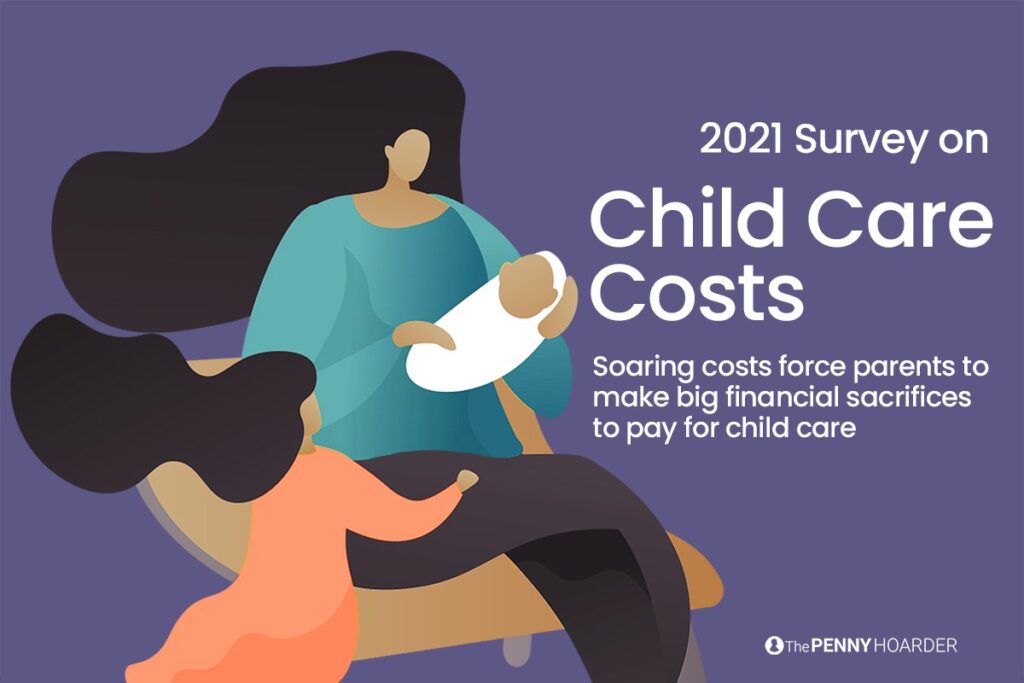[ad_1]
When you have a baby, you understand your life is going to change significantly.
You’re responsible for another human being. You’ll lose tons of sleep. And, of course, you’ll have a bunch of new expenses.
Diapers. Formula. Clothing. Toys. But one of the biggest expenses that hit parents is child care.
The Penny Hoarder surveyed 2,000 parents in September 2021 asking about how child care costs affected their lives. Despite extra financial support in the form of pandemic stimulus checks and child tax credits this year, a large majority of families feel overwhelmed.
The Financial Toll of Child Care
For working parents, child care is a necessity. Yet, it’s often challenging to secure and afford quality care.
“Working families across the country pay a significant percentage of their annual earnings to cover the price of child care,” said Mario Cardona, Chief of Policy and Practice for Child Care Aware of America, a national child care advocacy organization.
For many parents, it costs more to send their kids to day care than to put a roof over their heads.
“In the Midwest, Northeast and South, the price of full-time, center-based care for two children is the highest category of household expenses, including housing, transportation, food and health care,” Cardona said. “In the West, the price of child care for two children is surpassed only by the high price of housing.”
Half the parents we surveyed reported spending at least 25% of their income on child care. That’s a significant increase from when The Penny Hoarder surveyed parents about the cost of child care in 2018. Back then, the median percentage of income parents said they spent on child care was 15%.
Child Care Aware of America uses an affordability benchmark from the U.S. Department of Health and Human Services, which states that families who are receiving child care subsidies should not pay more than 7% of their income toward co-payments.
“We’ve used this benchmark to say that no family should pay more than 7% of income towards child care, whether they receive child care subsidies or not,” he said.
Following these guidelines, a family earning $5,000 a month should be paying no more than $350 a month for child care.
The Sacrifices Parents Make
The expense of child care forces parents to make hard choices.
Four out of 10 parents say they’ve gone into debt due to the cost of child care. Over a quarter of parents have had to move to a different home to afford child care. Almost 38% of parents have had to take on a second job or side hustle.
Having to pay a child care provider makes it tough to meet other financial responsibilities. Almost 28% of parents say they’ve had to choose between paying for child care or paying their rent or mortgage on time.
About 35% say they’ve had to choose between paying for child care or paying a credit card bill on time.
Not paying a bill on time often results in late fees, but for some families, an extra fee is better than losing a coveted spot at a child care center and facing the challenge of finding other arrangements.
Other parents figure that it makes more sense to leave the workforce than to spend so much of their income paying for child care. Nearly 1 out of 5 parents say they’ve had to quit a job due to the costs of child care.
Leaving the workforce has ripple effects beyond a loss of income. Many stay-at-home parents find it difficult to return to work due to gaps in their employment history. They lose out on opportunities for career advancement. Not having access to an employer-sponsored 401(k) plan means stay-at-home parents miss out on the ability to grow their retirement savings.
Help Needed
The Penny Hoarder’s survey on child care costs survey found that financial support during the pandemic has helped parents pay for child care.
Seventy percent of parents said stimulus check money helped with the cost of child care during the pandemic. Over 83% of those receiving monthly child tax credit payments said that money has helped with child care expenses this year.
This financial assistance, however, is temporary. About 1 in 5 parents receiving child tax credits reported that once the monthly payments end in December, they don’t believe they’ll be able to continue paying for care.
Methodology: The Penny Hoarder used Pollfish to conduct a national survey about the cost of child care with 2,000 people completing the survey Sept. 8-10, 2021. Survey responses are weighted so that each response is representative of the U.S. population.
Nicole Dow is a senior writer at The Penny Hoarder. Chris Zuppa, The Penny Hoarder’s multimedia content creator, contributed to this report.
[ad_2]

